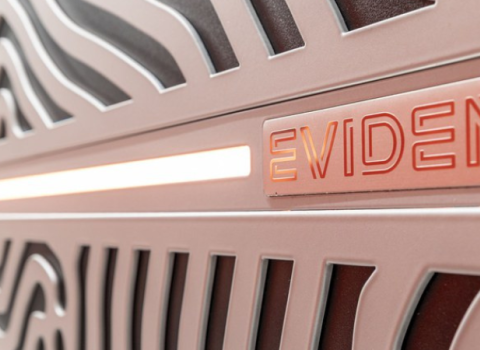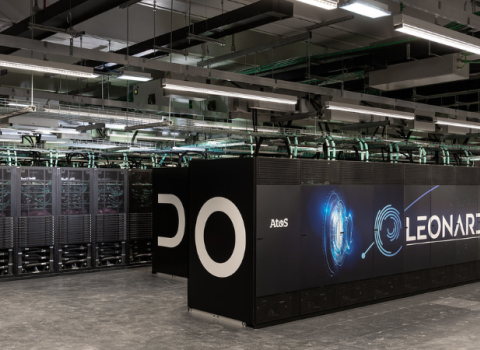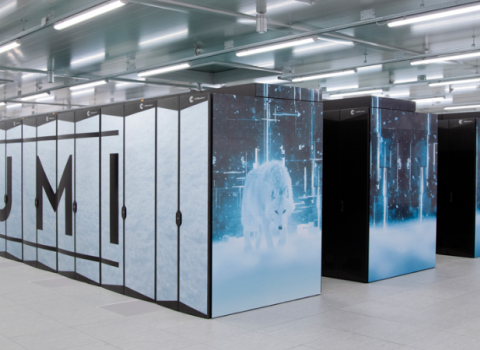Satoshi Matsuoka explains how his country is making a giant leap forward in energy efficient processing power

Satoshi Matsuoka (center) receives the Green500 prize for the world’s most efficient supercomputer. Photo: NVIDIA
Satoshi Matsuoka got his start in computers in the 1980s, when he co-developed a popular pinball game for the Super Nintendo games console. Now, some 40 years later, he’s leading Japan’s Fugaku project, which aims to build one of the fastest and greenest supercomputers in the world.
Matsuoka, head of the RIKEN Centre for Computational Science, the largest supercomputing centre in Japan, was appointed to lead Fugaku in April 2018. Last November the prototype placed first in the league of the world’s most energy efficient supercomputers.
“You get one benefit by [building] it; another benefit by using it,” Matsuoka said. “We need these machines to advance our IT systems, so as we can take a leading edge in the world,” he told Science|Business.
Supercomputers, seen as a yard stick of a country’s standing in science and technology, has long been a field where Japan was a leader. According to the latest data, published last November, seven of the top 50 most powerful machines are in Japan. That compares to 20 in the US and three in China.
Fugaku is the successor to RIKEN’s K supercomputer, which was the fastest in the world in 2011. K stands for Kei, the Japanese numeral denoting 10 quadrillion. The aim is that Fugaku will be 100 times faster, eventually reaching exascale performance, surpassing one quintillion calculations per second. That is roughly seven times the speed rating of the most powerful system built to date.
Matsuoka wants to make the Fugaku supercomputer, which has been under development since 2014, available for general use from next year. The K computer was decommissioned last year, to make way for the new machine.
From the ground up
“The computer will save lives,” Matsuoka said. “It will simulate adverse weather conditions; it will predict massive earthquake damage and anticipate global warming. It can help to discover new energy sources, new batteries and new drug targets.”
Companies will get access to the machine for processor-intensive tasks such as analysing geological data in oil exploration and or computer-aided drug design.
Matsuoka likens the machine to Japan’s highest mountain, Mount Fuji, saying it will have “a very high peak” of performance, “but a very broad base” of potential users.
Building Fugaku will involve integrating 150,000 microprocessors. “It’s like the internet of a whole city in a single room. They all have to talk to each other. It takes time to get that right,” said Matsuoka.
The finished product will be huge, taking up around 20 times as much space as Barcelona’s Mare Nostrum supercomputer, currently ranked at 30th most powerful in the world.
One of the most striking features of the new machine is its energy efficiency, Matsuoka says. The computer’s CPU chip is not only three times faster than the best Intel-made version available today, but will only use one third of the power, he said.
The computer will also be essential for ensuring Japan’s IT competitiveness, Matsuoka says. “There is a huge army of people behind this. Thousands – chip makers, software, manufacturers, investors. It’s the largest endeavour in supercomputing in the history of Japan,” he said. “If it’s not a difficult thing to do, why even do it?”
“You want this technology to travel; to disseminate to others. It doesn’t end with one machine – you want the chips and their successors to end up in computers and cloud data centres everywhere,” he said. “You will also need supercomputers like this to build quantum computers,” he added.
The computer’s energy efficiency potential has convinced the US supercomputer manufacturer Cray to adopt some of the component technologies.
It’s a point of particular pride for Matsuoka. “Cray never used Japanese processors before. Ever since I started in this career, the dream was that someday we’d build technology that was good enough to go into US institutions. Now we’ve developed something that’s going to American universities and government laboratories for the first time ever,” he said.
In terms of the top 10 supercomputers in the world, the US remains the leader with five computers. They are at government research facilities.
The supercomputer rankings, published every six months for the world’s 500 most powerful systems, change frequently and reflect how fast computer power is advancing. The current swiftest system is at Oak Ridge National Laboratory in Tennessee, occupying a space equivalent to two basketball courts.
China has made huge investments in supercomputing and now threatens the upper echelon of the field. The country holds two of the top five spots in the latest chart, published in November 2019, with 228 systems on the overall 500 list, compared with 117 for the US. Japan has 29 machines in the current top 500.
The combined power of the Top500 is projected to double in 2021, with the US expected to fire up two new supercomputers, Frontier and Aurora.
Pinball wizard
Matsuoka, a prolific high-performance computing pundit on Twitter, says his early student days gave him a solid grounding in computers.
“I teamed up with Satoru Iwata, who later became CEO of Nintendo,” he said. “Together we wrote the core part of Pinball in a month-and-a-half using machine code. It was very restrictive. Even the processor in my fridge now is faster than [the Super Nintendo]. I still remember the algorithms, and the details of the code.
“I cherish those days. But games are a long way from my mind – I think I have other important things to worry about now,” he said.





 A unique international forum for public research organisations and companies to connect their external engagement with strategic interests around their R&D system.
A unique international forum for public research organisations and companies to connect their external engagement with strategic interests around their R&D system.